Overview
Navigating the EB-2 NIW processing time can be daunting, especially for immigrant workers. Significant delays often arise due to visa caps, particularly for applicants from high-demand countries like India and China, where wait times can exceed five years.
Have you ever felt overwhelmed by such long delays? Understanding the phases of this process is crucial. Timely filing and thorough documentation can make all the difference. It's also essential to:
- Monitor priority dates closely
- Be prepared for Requests for Evidence (RFEs), which can further extend processing times
Remember, you’re not alone in this fight—we’re here to guide you every step of the way.
Introduction
Navigating the complexities of the EB-2 National Interest Waiver (NIW) processing time can feel overwhelming for many immigrant workers. With recent updates revealing that all available EB-2 visas for fiscal year 2025 have been exhausted, the need for timely applications has never been more urgent. This article explores ten essential insights that clarify the intricacies of the EB-2 NIW processing timeline and equip candidates with the knowledge necessary to enhance their chances of success amidst potential delays and challenges.
How can applicants prepare effectively and strategize to overcome the hurdles posed by processing times, country-specific factors, and the ever-evolving immigration landscape?
Vasquez Law Firm: Expert Guidance on EB-2 NIW Processing Time
Vasquez Law Firm stands as a leader in immigration law, particularly in National Interest Waiver (NIW) cases. With over 15 years of specialized experience, we offer tailored support to immigrant workers, guiding them through the complexities of .
Have you ever felt lost in the immigration process? Recent updates reveal that all available EB-2 visas for fiscal year 2025 have been issued, pausing new approvals until the reset on October 1, 2025. This makes it essential for candidates to file their cases promptly if their priority dates are current under the September Visa Bulletin.
Our commitment to client advocacy ensures that candidates receive comprehensive preparation and support throughout the process, significantly improving their chances of success. It’s important to know you have rights, even if others tell you otherwise.
Approval rates for NIW applications remain positive, with many qualified individuals achieving consistent approvals in early 2025. By leveraging our expertise, clients can navigate the intricacies of the immigration system with confidence, positioning themselves for a successful outcome.
We’re here to fight for your family—your future matters to us.
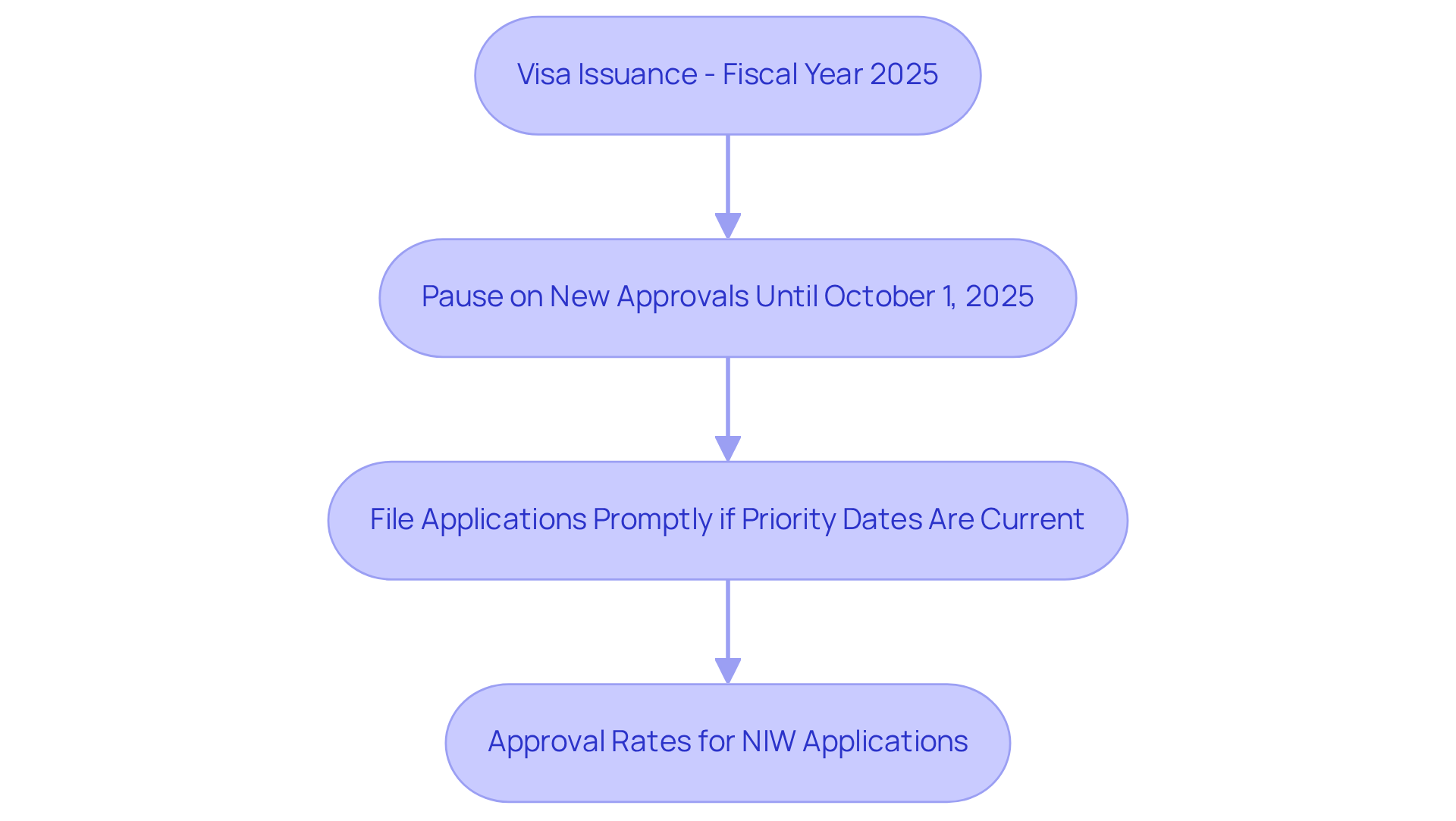
Understanding the EB-2 NIW Processing Timeline: Key Phases Explained
Navigating the eb2 niw processing time can feel overwhelming, but understanding its essential phases is key to your success.
- Preparation of the I-140 Petition is the first step, typically taking 1 to 3 months. This duration varies based on the complexity of your case and how thoroughly you've prepared your documentation, which can affect the eb2 niw processing time.
- Next comes the USCIS Processing of the I-140. After submission, expect this phase to last between 6 to 12 months. Keep in mind that the eb2 niw processing time can fluctuate significantly depending on the service center's workload and your country of chargeability.
- Importantly, no new EB-2 green card approvals will occur until October 1, 2025, a crucial detail for your planning.
- Finally, after I-140 approval, you will enter the eb2 niw processing time phase, which includes either Adjustment of Status (I-485) or Consular Processing. This can take an additional 6 to 24 months, influenced by visa availability and your country of origin. Candidates from high-demand nations like India and China often face longer wait times due to backlogs.
- For those seeking faster resolutions, premium processing is an option, allowing for a decision on the I-140 petition within 45 days.
Understanding these phases is not just informative; it’s vital for and managing your expectations. Remember, you’re not alone in this fight—we’re here to support you every step of the way.
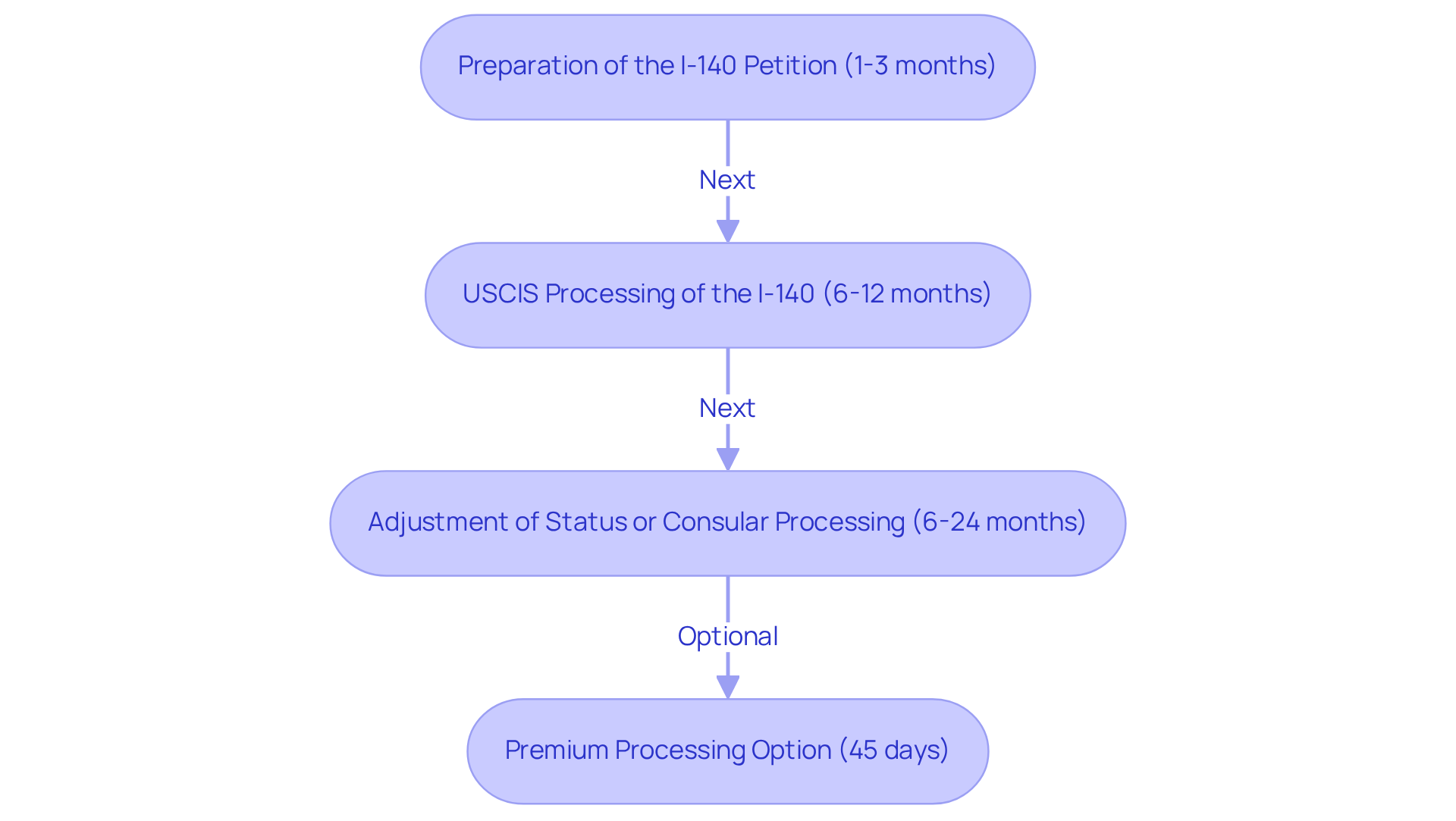
Factors Affecting EB-2 NIW Processing Time: What You Should Know
Several factors significantly influence the eb2 niw processing time, and understanding them is crucial for applicants navigating this challenging journey.
First, consider the USCIS Workload. The agency is currently grappling with a historic backlog of 11.3 million pending applications. This situation has led to unprecedented delays in turnaround times. In Q2 2025, USCIS completed only 2.7 million cases, marking an 18% decline from the previous year. This backlog directly impacts the eb2 niw processing time, resulting in longer wait times for those seeking approval.
Next, we have the Complexity of Individual Cases. Each application may present unique challenges that require additional documentation or clarification. This complexity can lead to , which are becoming more frequent and can extend timelines by several months. Immigration specialists note that RFEs often arise when evidence is vague or does not clearly meet USCIS criteria, further complicating the timeline.
Additionally, Country-Specific Visa Caps play a significant role. Applicants from high-demand countries like India and China face particularly long wait times due to annual visa caps. Even after I-140 approval, these candidates may experience considerable delays before they can proceed with Adjustment of Status or consular procedures, as they must wait for their priority dates to become current. The typical duration for the EB2 NIW processing time for the I-140 application is approximately 6 to 12 months, but this may be prolonged due to the factors mentioned above.
Comprehending these elements is essential for candidates to prepare efficiently and foresee possible setbacks in their NIW process. Remember, you are not alone in this fight; we’re here to support you every step of the way.
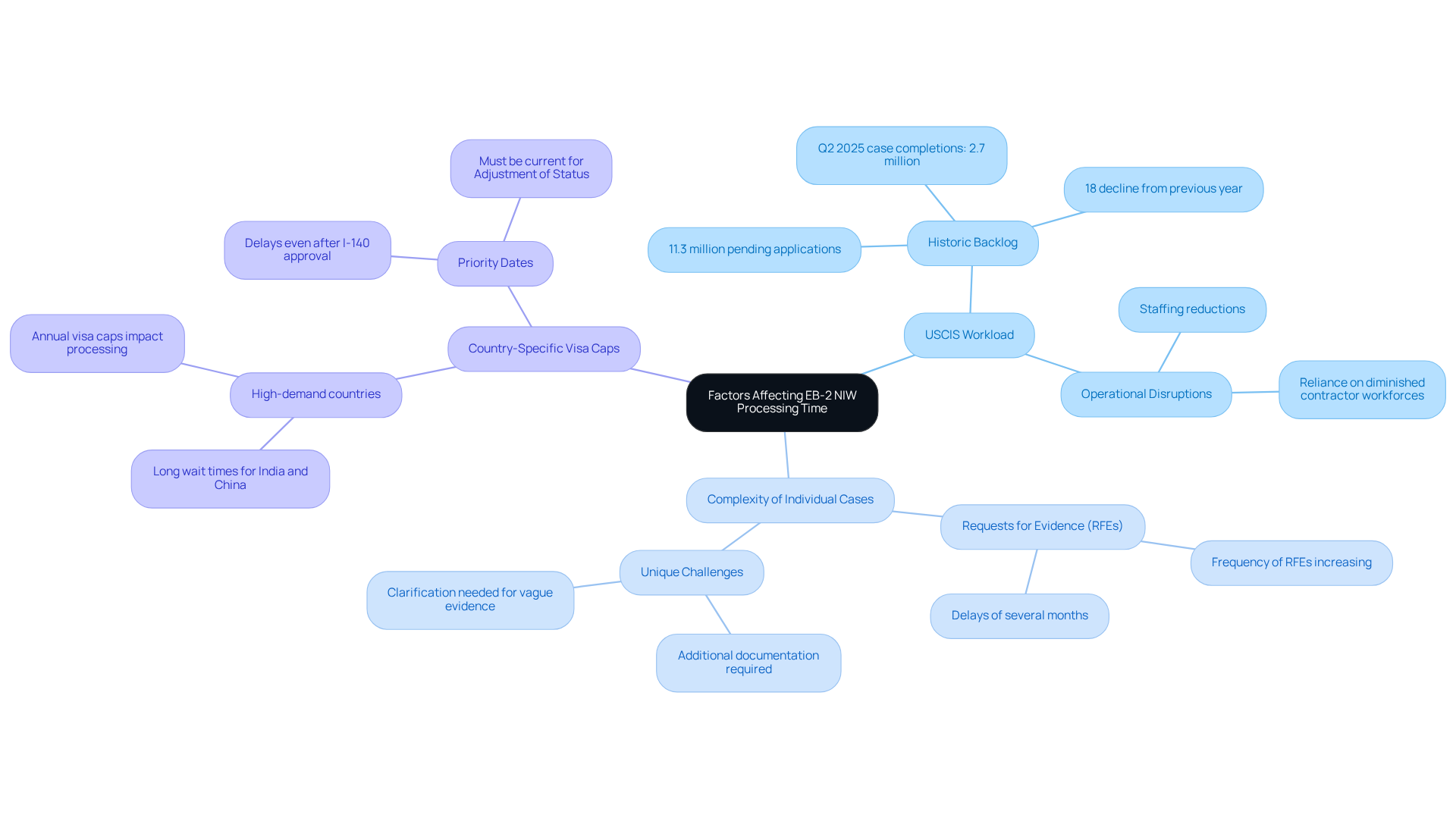
Premium Processing for EB-2 NIW: Is It Worth the Investment?
Premium handling for EB-2 NIW candidates significantly enhances the EB2 NIW processing time, offering a critical advantage: a guaranteed decision on their I-140 petitions within just 45 calendar days for an additional fee of $2,805. This expedited service can dramatically reduce waiting times, which is especially vital for those facing urgent career opportunities or job changes. However, it’s essential to understand that while premium expedited service accelerates the I-140 decision, it does not affect the overall green card process, which still depends on visa availability and other factors, including the eb2 niw processing time and the I-485 adjustment of status procedure.
When considering whether premium handling is a wise investment, individuals should evaluate their specific circumstances. For example, those with pressing deadlines may find this expedited service invaluable, despite the extra cost. Legal experts often emphasize that the decision should weigh the urgency of the applicant's situation against the financial implications. As one immigration lawyer noted, 'Premium handling can be a beneficial choice for many EB-2 NIW applicants, as it significantly improves the EB2 NIW processing time, ensuring quicker resolutions and enhanced reassurance.'
Real-life examples highlight the strategic benefits of premium processing. Many candidates have shared that the ability to secure a faster I-140 approval allowed them to focus on their professional goals without the stress of prolonged waiting periods. However, for applicants from countries with significant backlogs, such as India or China, the advantages may be less evident, as the overall timeline for green card approval can still be extensive.
Ultimately, candidates should weigh the costs against their urgency and unique needs, keeping in mind that can range from approximately $2,680 to $5,485 or more, depending on individual situations and whether legal representation is included.
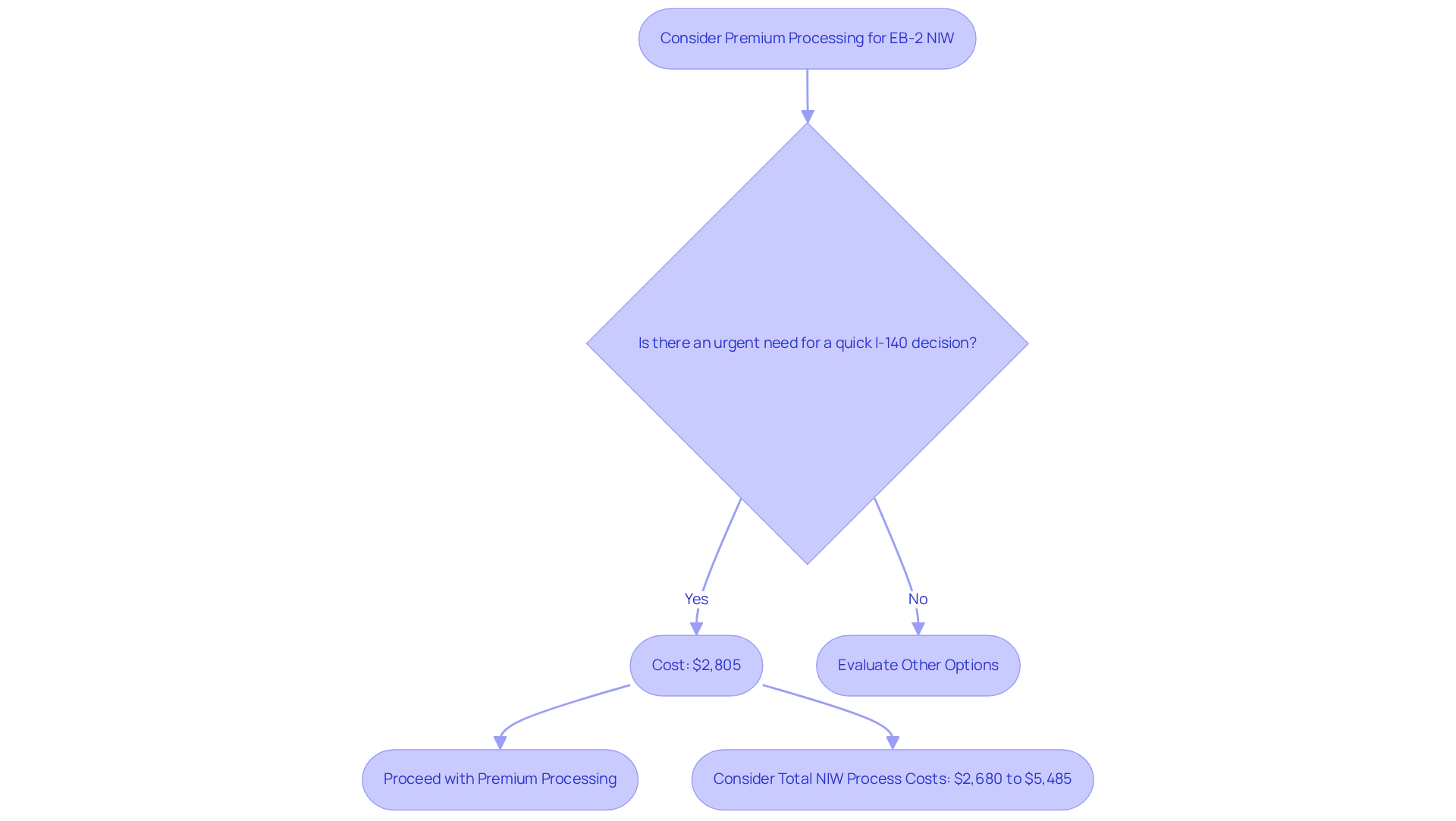
Understanding Priority Dates in EB-2 NIW Applications: A Crucial Insight
Priority dates play a crucial role in the NIW application process, determining an individual's position in line for visa processing. When the I-140 petition is filed, the is established. However, applicants from countries with high demand, such as India and China, often face longer wait times due to retrogressed priority dates. For instance, the final action date for India has retrogressed to January 1, 2013, while the final action date for China remains current at December 15, 2020. This disparity highlights the struggles many candidates encounter.
Furthermore, the annual limit for EB-2 visas is capped at 28.6% of the worldwide employment limit, and all available immigrant visas in the EB-2 category for fiscal year 2025 have already been issued. Staying informed about the Visa Bulletin is essential for understanding when you can proceed with your application. Regularly monitoring these updates allows you to prepare for potential shifts in your priority dates, ensuring you're ready to act when your turn arrives.
Immigration lawyers stress the importance of maintaining valid status and exploring alternative immigration options during these long waits. Document organization is also vital during multi-year waits, as medical exams expire and financial documents require updates. Understanding these dynamics is key for effective planning and navigating the complexities associated with the EB-2 NIW processing time. Remember, you’re not alone in this fight—we’re here to support you every step of the way.
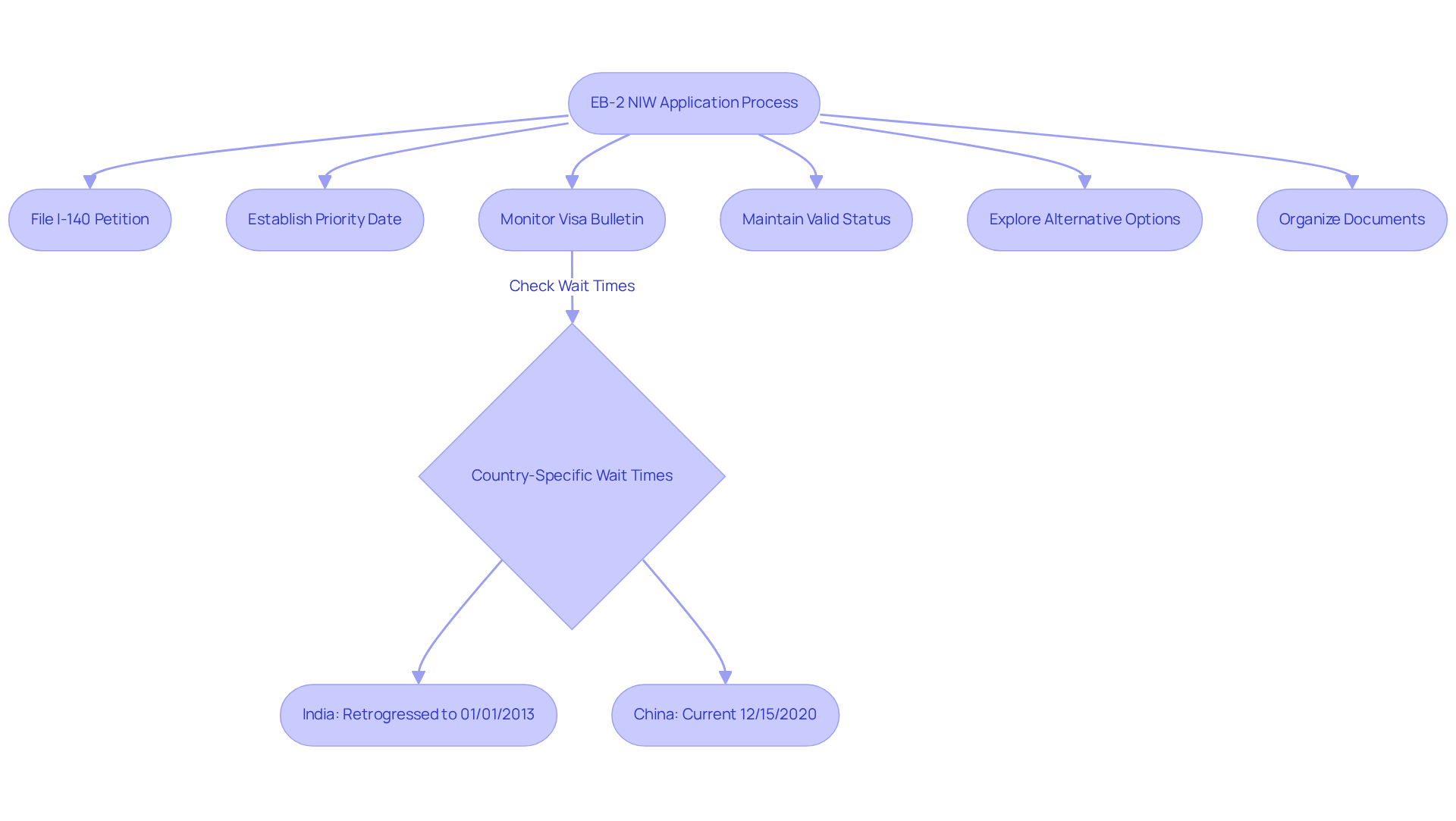
Common Challenges in EB-2 NIW Processing: How to Navigate Delays
Navigating the NIW application process can be daunting, especially when faced with Requests for Evidence (RFEs) that may impact the EB-2 NIW processing time by several months. USCIS typically allows to an EB-2 NIW RFE, plus additional days for mail delivery, underscoring the need for timely replies. RFEs often stem from incomplete documentation or insufficient demonstration of how your work serves the national interest. For example, a petitioner proposing a business in accounting struggled to provide adequate evidence of its economic impact, leading to an RFE that extended their timeline. Similarly, another candidate failed to clearly articulate how their work would benefit the U.S. economy, resulting in further scrutiny and delays.
To effectively manage RFEs, prioritize meticulous documentation and clarity in your submissions. Immigration attorneys stress that a well-structured response can significantly enhance your chances of approval. Nicole Gunara, a principal immigration lawyer, emphasizes that RFEs are not denials but opportunities to clarify and strengthen your case. She advises candidates to link their accomplishments directly to the legal standards necessary for approval, focusing on three primary concerns that RFEs typically address:
- Establishing national significance
- Illustrating your role
- Substantiating the labor certification exemption
Moreover, the average delay caused by RFEs can considerably extend the EB-2 NIW processing time, often requiring responses within 30 to 90 days. This timeframe is critical; timely and thorough responses are essential for advancing your case. By addressing the specific concerns raised in RFEs and providing concrete evidence of your work's national significance—such as recent recommendation letters and updated citation counts—you can significantly improve your chances of a favorable outcome in the NIW process.
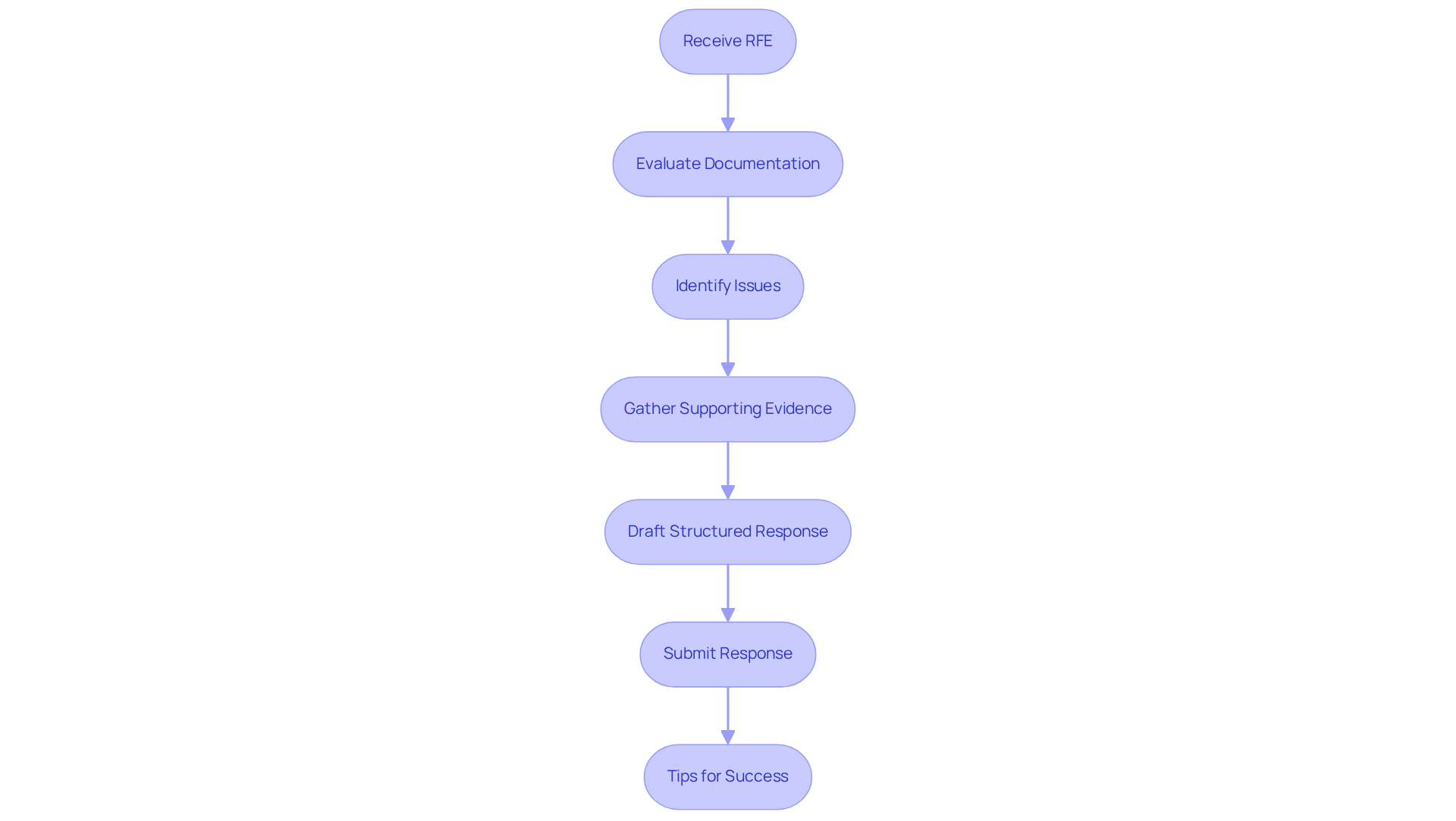
Tracking Your EB-2 NIW Application Status: Tools and Tips
Are you feeling lost in the immigration process? Applicants can efficiently monitor their EB-2 NIW processing time by checking their application status on the USCIS website using their receipt number. Regularly checking this status is crucial, as it keeps you informed about any updates or requests from USCIS. Given the operational disruptions at service centers due to staffing reductions, you may experience delays in case intake and movement.
But don’t worry—utilizing advanced case tracking applications can improve this process by offering real-time updates and notifications, ensuring you stay informed about your application's progress. Tools like Lawfully provide and automatic case status tracking, significantly alleviating the stress of uncertainty during the waiting period.
Immigration experts emphasize the importance of these resources, allowing you to remain proactive in handling your case. As Frances Rayer, a member of the immigration community, states, "These tools assist individuals in maneuvering through the complexities of the NIW process with greater confidence and clarity."
By utilizing these resources, you can better set realistic expectations regarding your application status, especially considering that Requests for Evidence (RFEs) can add 3-6 months or more to the EB-2 NIW processing time. Remember, you’re not alone in this fight—we’re here to support you every step of the way.
![]()
Essential Documentation for EB-2 NIW: What You Need to Prepare
Navigating the EB-2 NIW processing time can feel overwhelming. To succeed, you need a robust set of documents. Start with Form I-140, the primary application form that kicks off the process. Next, provide evidence of your advanced degree or exceptional ability—this is crucial to demonstrate your qualifications through degrees or proof of exceptional skills in your field. Don't forget letters of recommendation; these should be detailed and specific, coming from credible experts who can attest to your contributions and significance in your area of expertise. Letters of support from government or quasi-governmental agencies can also carry significant weight in your application. Additionally, include a detailed petition letter that clearly outlines how your work serves the national interest, addressing the three-prong test established by USCIS. Finally, relevant publications or citations can significantly bolster your application by showcasing your impact in your field.
Organizing and presenting these documents thoroughly is vital—after all, the quality of your evidence directly influences approval rates. With the current hovering around 43% and a denial rate reported at 18% in FY 2024, meticulous preparation is more important than ever to stand out in this competitive landscape. Be aware of the backlog of pending cases affecting EB-2 NIW processing time, which adds to the challenges you may encounter. The revised USCIS policy manual in 2025 clarifies how officers assess petitions and what qualifies as 'national interest,' making it crucial for you to align your documentation with these guidelines. Remember, you’re not alone in this fight—your future matters to us, and we’re here to support you every step of the way.
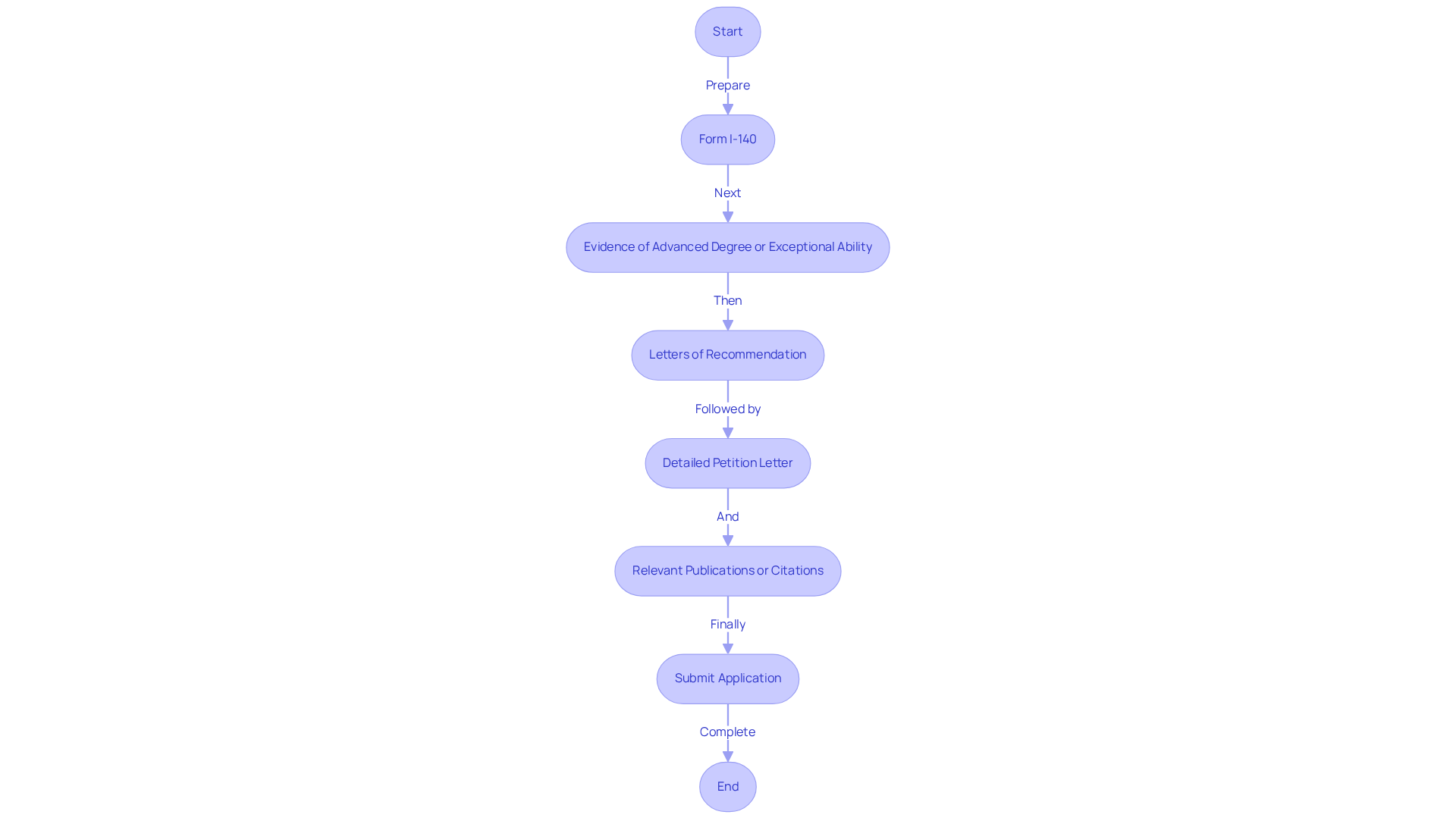
Country-Specific Factors Influencing EB-2 NIW Processing Times
The eb2 niw processing time for NIW applications can feel overwhelming, especially when influenced by the individual's country of origin. High-demand countries like India and China often face significant delays due to strict visa caps and extensive backlogs. For instance, Indian candidates frequently encounter wait times that exceed five years, primarily because of priority date retrogression, even after their I-140 petitions are approved. In contrast, individuals from nations with lower demand, such as Pakistan and Bangladesh, typically experience an eb2 niw processing time of 12 to 18 months, benefiting from less competition for available visas.
Understanding these country-specific dynamics is crucial. As one expert noted, "The restricted quantity of green cards granted per country annually results in extended wait periods for candidates from oversubscribed nations." This insight underscores the necessity for candidates to monitor the Visa Bulletin closely and consider alternative pathways, such as upgrading to EB-1 or EB-5 visas, which may offer quicker processing times.
Real-world examples illustrate these disparities vividly. While the majority of NIW petitions from Pakistan and Bangladesh are , the eb2 niw processing time for individuals from India often involves prolonged waits, occasionally lasting over ten years. Additionally, pending applications surged by 1.6 million, reaching a decade-high of 11.3 million, highlighting the current challenges in the immigration system. This stark contrast emphasizes the critical role that country of origin plays in the NIW application process, making it essential for candidates to strategize accordingly. Remember, you’re not alone in this fight—we’re here to support you every step of the way.
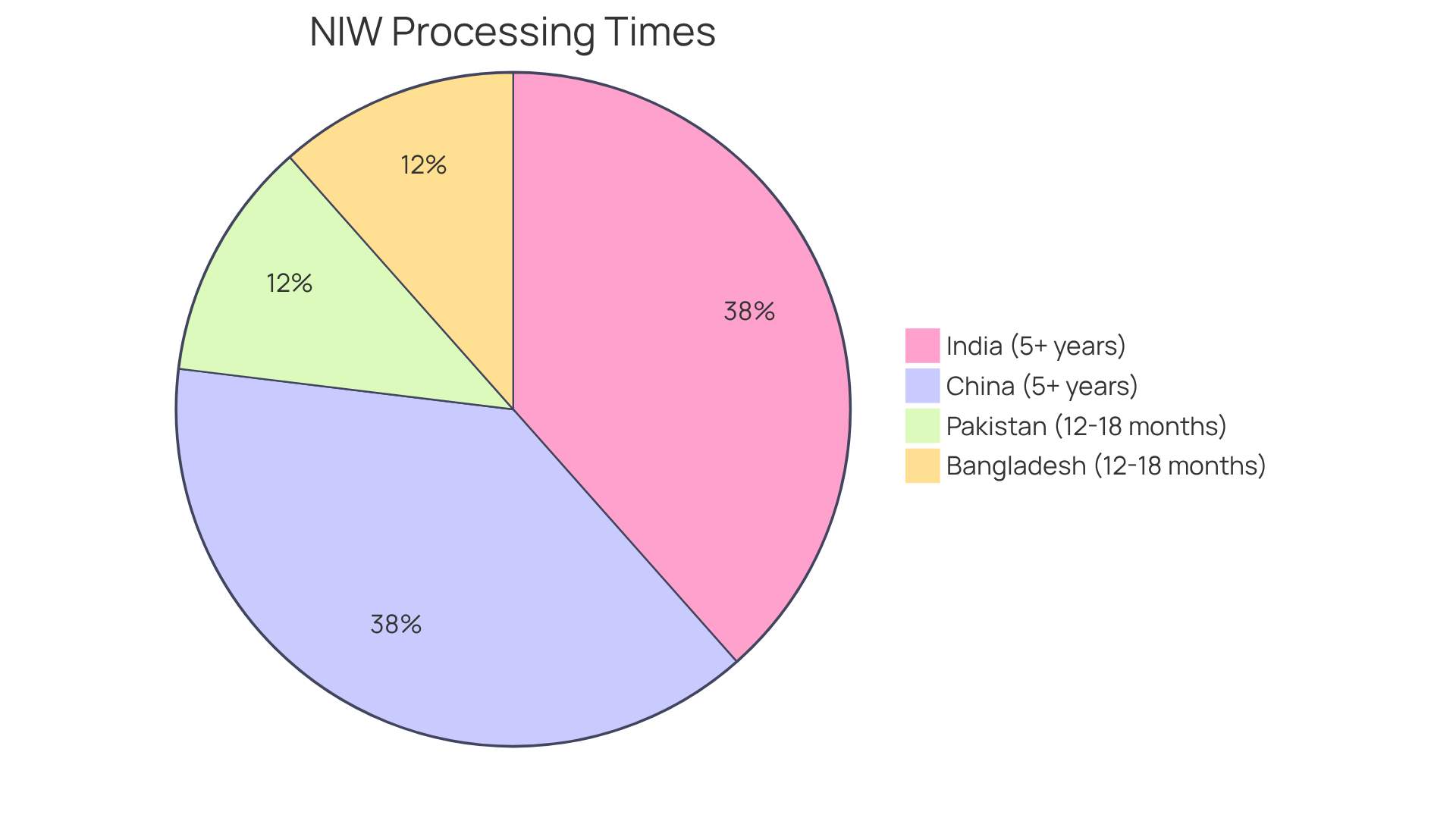
Key Takeaways on EB-2 NIW Processing Time: Essential Insights
Navigating the eb2 niw processing time can feel overwhelming. It’s crucial to understand the key phases and factors that influence timelines, especially the importance of thorough documentation. Successful candidates often share strategies that emphasize careful preparation of evidence and alignment with USCIS criteria. For example, those who effectively showcase their contributions to national interest through detailed portfolios tend to experience higher approval rates.
The eb2 niw processing time for petitions can vary significantly. The eb2 niw processing time for regular processing typically takes about 14 to 19 months, while can expedite the I-140 adjudication to as little as 45 days. However, if you’re from countries with high demand, like India and China, you may still face prolonged wait times of 1.5 to 2 years due to visa backlogs. It’s essential to stay updated on priority dates and the Visa Bulletin, as these elements directly affect when you can move forward in the Green Card process.
Be prepared for possible Requests for Evidence (RFEs), which are common when documentation lacks specificity or clarity. As Henry Lindpere notes, "RFEs are common, especially when evidence is vague or doesn’t map clearly to USCIS criteria." By leveraging expert guidance and ensuring comprehensive preparation—including submitting Form I-140, a detailed petition letter, and an evidence portfolio—you can significantly enhance your chances of a successful EB-2 NIW application. Remember, you’re not alone in this fight; we’re here to support you every step of the way.

Conclusion
Navigating the complexities of EB-2 NIW processing time can feel overwhelming for immigrant workers. It’s crucial to understand the application process, from preparing the I-140 petition to facing potential delays from Requests for Evidence (RFEs) and country-specific visa caps. With the current backlog and the pause in new EB-2 approvals until October 2025, strategic planning is essential for candidates aiming to enhance their chances of success.
Consider the impact of USCIS workload on processing times, the benefits of premium processing, and the importance of staying aware of priority dates. Candidates from high-demand countries like India and China encounter unique challenges, often facing significantly longer wait times. However, with meticulous documentation and a solid grasp of application requirements, their chances of approval can improve.
The EB-2 NIW process is more than just a bureaucratic hurdle; it’s a pathway to a brighter future. By remaining informed and proactive, candidates can navigate this intricate system with confidence. Engaging with expert guidance and utilizing available resources can significantly influence the outcome. Remember, you are not alone in this journey toward securing your immigration status. We’re here to fight for your family, ensuring that support is available every step of the way. Your future matters to us—Yo Peleo — We Fight.
Frequently Asked Questions
What is the EB-2 NIW processing time?
The EB-2 NIW processing time involves several phases, including preparation of the I-140 petition (1 to 3 months), USCIS processing of the I-140 (6 to 12 months), and either Adjustment of Status (I-485) or Consular Processing (6 to 24 months).
What are the key phases in the EB-2 NIW processing timeline?
The key phases include: 1. Preparation of the I-140 Petition (1 to 3 months). 2. USCIS Processing of the I-140 (6 to 12 months). 3. Adjustment of Status or Consular Processing (6 to 24 months).
Why are there no new EB-2 green card approvals until October 1, 2025?
All available EB-2 visas for fiscal year 2025 have been issued, pausing new approvals until the reset on October 1, 2025.
What factors can affect the EB-2 NIW processing time?
Factors affecting processing time include: - USCIS Workload: A historic backlog of 11.3 million pending applications has led to significant delays. - Complexity of Individual Cases: Unique challenges may require additional documentation or clarification, leading to Requests for Evidence (RFEs), which can extend timelines. - Country-Specific Visa Caps: Applicants from high-demand countries like India and China may face longer wait times due to annual visa caps.
How does the USCIS workload impact processing times?
The USCIS is currently dealing with a backlog of 11.3 million pending applications, resulting in longer wait times for approvals. In Q2 2025, USCIS completed only 2.7 million cases, marking an 18% decline from the previous year.
What is premium processing and how does it affect the I-140 petition?
Premium processing is an option that allows for a decision on the I-140 petition within 45 days, providing a faster resolution for applicants seeking expedited processing.
How can candidates prepare for potential delays in the EB-2 NIW process?
Understanding the factors that influence processing times, such as USCIS workload, case complexity, and country-specific visa caps, can help candidates prepare efficiently and anticipate possible setbacks in their NIW process.




